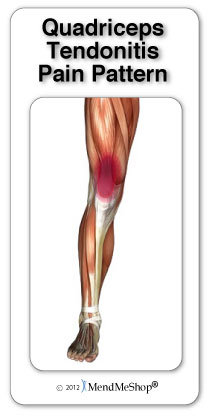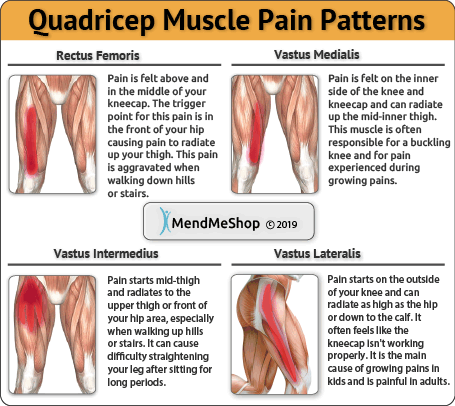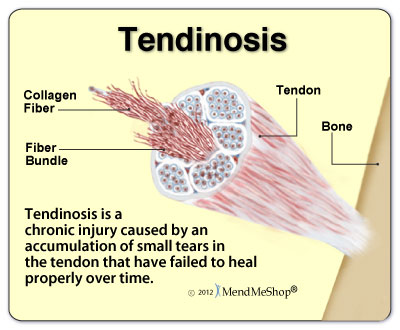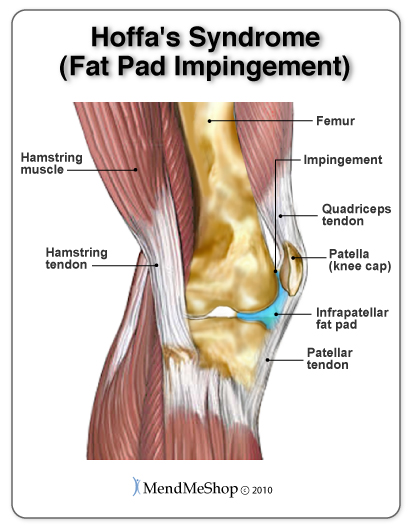|
| Quadriceps TendinitisSymptoms of Quadriceps Tendinitis If you are suffering from Quadriceps Tendinitis pain in the area at the bottom of the thigh, just above the knee cap. The most noticeable pain is when you move your knee, the more you move the more tenderness develops in the area of the tendon attachment just above the kneecap.
Causes of Quadriceps TendinitisQuadriceps tendonitis is caused by repetitive use of this tendon. This condition is most common in an athlete who are involved in sports that require a lot of jumping such as basketball, volleyball and jogging, or in a sport that requires a lot of stopping and starting.  Inflammation in the quadriceps tendon is often due to irritation and/or micro-tearing of the collagen fibers. When the fibers tear, they become weaker, inflamed and swollen causing pain and tenderness in the area. There are 2 types of tendonitis, acute and chronic. Acute quadriceps tendonitis refers to inflammation that comes on suddenly, usually from a tendon strain or overloading it during exercise. Chronic quadriceps tendonitis occurs over time and generally results from long term repetitive use of the quadriceps tendon. With both types of tendinitis, scar tissue develops on the tendon as the tears begin to heal. This scar tissue mends the tears in an abnormal way leaving the collagen fibers weaker and more prone to further injury. In the case of chronic quadriceps tendinitis, a build up of scar tissue over a long period of time will make the tendon and the entire knee joint more prone to re-injury.  Quadriceps Tendinitis Risk Factors include:
Do You Really Have Quadriceps Tendinitis?Other conditions which can be a cause of anterior (front) knee pain are commonly confused with quadriceps tendonitis.  Quadriceps Tendinosis - Tendinosis refers to a non-inflammatory, degeneration of the collagen fibers in a tendon. This tissue break down is often caused by repetitive stress on the tendon fibers and the failure for the fibers to heal. Partial Quadriceps Tendon Tears - Usually seen in people over the age of 40 as the tissue as part of aging degenerates. A sudden trauma to the tendon may cause it to tear or may spontaneously tear with people suffering from diabetes mellitus, gout, systemic lupus erythematosus, rheumatoid arthritis, end-stage renal disease, prolonged systemic steroid use or hyperparathyroidism. Early surgical repair within 27hrs is the key to successful healing of the tendon. (source: National Library of Medicine) Quadriceps Tendon Complete Ruptures - If you are suffering from a complete rupture of the quadriceps tendon you will have a very painful and swollen knee. The rupture has left you unable to walk or you may walk with assistance or holding your leg as straight as possible. You may notice a gap in the tendon just above the kneecap where the muscle and tendon have broken away from the bone. Early surgical repair within 27hrs is the key to successful healing of the tendon. (source: National Library of Medicine) Synovial Plicae - Weakness in the knee as if it is unstable while walking up or down stairs or slopes. Pain with the extension of the knee, as well as may hearing a cracking noises when flexing and straightening your knee. Known as "pathological synovial plica syndrome" considered a embryonic relic. At the 12th week of life the synovial plica forms in the knee, as we grown and mature this tissue then is becomes entangled within the knee and is unable to dissolve and remains in our adulthood. Estimated that 50% of the population has the 'plicae' after birth. It is common for this condition to be over looked by doctors. (source: National Library of Medicine) Calcific Tendinitis - A chemical reaction in the body, after injury to the soft tissue, the body is healing but instead of healthy tissue, it creates calcium in the tendon. If you are suffering calcific tendinitis of the quadriceps tendon, you may have pain and stiffness that may last for a few weeks to two months and suddenly disappear. If calcific tendinitis is return a number of times is now chronic you may notice your pain linger for a few months to years. Chondromalacia Patella - Causes a dull, aching pain in the front of your knee. There is damage or softening of the cartilage on the underside of the knee cap. Pain while walking up or down stairs, kneeling or squatting or after sitting for long periods of time with your knee bent.  Hoffa's syndrome or fat pad impingement - Pain, inflammation, and swelling at the front of the knee cap and along the sides of the patellar tendon. Increased pain when standing for long periods of time, squatting or using stairs and or pain when you extended you knee. Hoffa's syndrome is caused by at pad either suffers a contusion or an injury, resulting in damage and swelling. This can lead to the Hoffa's pad becoming trapped between the femur and the patella every time the leg is extended. Patellofemoral Subluxation - Pain on the sides and around the knee cap. The kneecap slides up and down in a groove on the end of the thigh bone (trochlear groove). In some people the kneecap is pulled toward the outside of the knee and the kneecap does not slide in its groove. This condition normally affect adolescents and younger children. Patellofemoral Arthritis - Causes pain in the front of your knee and can make it difficult to kneel or climb stairs. The kneecap slides up and down in a groove on the end of the thigh bone (trochlear groove). Patellofemoral arthritis occurs when the cartilage along the trochlear groove and on the underside of the patella wears down and becomes inflamed. Conditions that may be associated with quadriceps tendonitis include diabetes, hyper-pressure, gout, and para-hypothyroidism. Quadriceps Tendonitis DiagnosisA visit to your doctor is really the best and only way for a proper diagnosis of any type of knee pain. To help your doctor achieve a proper diagnosis, he/she will begin with a medical history about you, your current condition and symptoms. He/she will inquire about the intensity of your present pain, the duration of your symptoms and the limitations you are experiencing. Details about what instigated the problem, when it started, and whether or not you have ever had treatments for this or a similar condition in the past, are very helpful in assessing your injury. Diagnostic testing may be ordered help discover your source of knee pain. Often used to rule out other conditions. X-rays will provide a two-dimensional image of the overall structure of your knee. They are helpful in identifying knee instability, abnormal bone shapes (bone spurs or bone cysts, fractures, wear and tear on the joints). MRIs (magnetic resonance imaging) will provide more detailed information and will help to evaluate the soft tissues in and around your knee (muscles, tendons, ligaments, and other connective tissues). It can identify ligament or tendon damage, and can help to determine the extent of your injury, the displacement and degree of your tear or inflammation, as well as other associated knee conditions. Quadriceps Tendonitis - Conservative TreatmentsYour doctor will assess your particular case and determine a course of action. In most cases, a conservative treatment protocol will be enough to heal the injury, though in cases such as significant tearing or a fully ruptured quad, you will most probably require surgery. It is generally understood by doctors and surgeons, that surgery will introduce more scar tissue into the any already damaged tissue. This added scar tissue will be problematic, requiring more PT and conservative treatment options post-surgery. If not dealt with properly, your muscle injury could end up in worse condition than before the surgery! This is why surgery is only performed as a last resort. To view more information about conservative treatments for quadriceps tendinitis, please go to our quadriceps tendinitis treatment page here on aidyourtendon.com.During your recovery, you will probably have to modify and/or eliminate any activities that cause pain or discomfort in your knee area until your pain and inflammation settle. The more diligent you are with your treatment and rehabilitation, the faster you will see successful results! We recommend that you consult your doctor and/or physiotherapist before using any of our outstanding products, to make sure they're right for you and your condition. Product specialists are available 9:00 am to 5:00 pm Eastern Standard Time Monday to Friday. If any question or concern arises, call us or simply send us an email at any time (we check our emails constantly all throughout the day and night.. even on holidays!). We will respond as soon as possible. North America Toll Free 1-866-237-9608 |
      |








